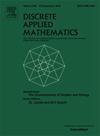Further acceleration in computing the gap greedy spanner: An empirical approach
IF 1
3区 数学
Q3 MATHEMATICS, APPLIED
引用次数: 0
Abstract
Consider a set of points on the plane and a weighted geometric network where the weight of each is equal to the Euclidean distance between the endpoints of the edge (). Given a constant , a spanning subgraph of is said to be a -spanner, or simply a spanner, if for any pair of nodes in there exists a path between and whose length is at most times their distance in .
Gap greedy spanner, proposed by Arya and Smid, is a light weight and bounded degree spanner in which a pair of points is guaranteed to have a -path, if there exists at least one edge with some special criteria in the spanner. In our previous work, we introduced an algorithm with linear space complexity that takes time to construct this spanner, utilizing well-separated pair decomposition. However, empirical results from experiments revealed that the performance of the algorithm is significantly dependent on the number of well-separated pairs obtained. In this paper, to mitigate the construction dependency on the number of well-separated pairs, we confine its usage to the processing of a small subset of point pairs. This limitation stems from the observation that a substantial portion of the edges in this spanner have small sizes. Consequently, we first empirically highlight the prevalence of the small edge size characteristic within the spanner. Subsequently, we propose an algorithm for computing this spanner that, based on the experimental results, exhibits a higher computational speed in generating the gap greedy spanner in most cases.
求助全文
约1分钟内获得全文
求助全文
来源期刊

Discrete Applied Mathematics
数学-应用数学
CiteScore
2.30
自引率
9.10%
发文量
422
审稿时长
4.5 months
期刊介绍:
The aim of Discrete Applied Mathematics is to bring together research papers in different areas of algorithmic and applicable discrete mathematics as well as applications of combinatorial mathematics to informatics and various areas of science and technology. Contributions presented to the journal can be research papers, short notes, surveys, and possibly research problems. The "Communications" section will be devoted to the fastest possible publication of recent research results that are checked and recommended for publication by a member of the Editorial Board. The journal will also publish a limited number of book announcements as well as proceedings of conferences. These proceedings will be fully refereed and adhere to the normal standards of the journal.
Potential authors are advised to view the journal and the open calls-for-papers of special issues before submitting their manuscripts. Only high-quality, original work that is within the scope of the journal or the targeted special issue will be considered.
 求助内容:
求助内容: 应助结果提醒方式:
应助结果提醒方式:


